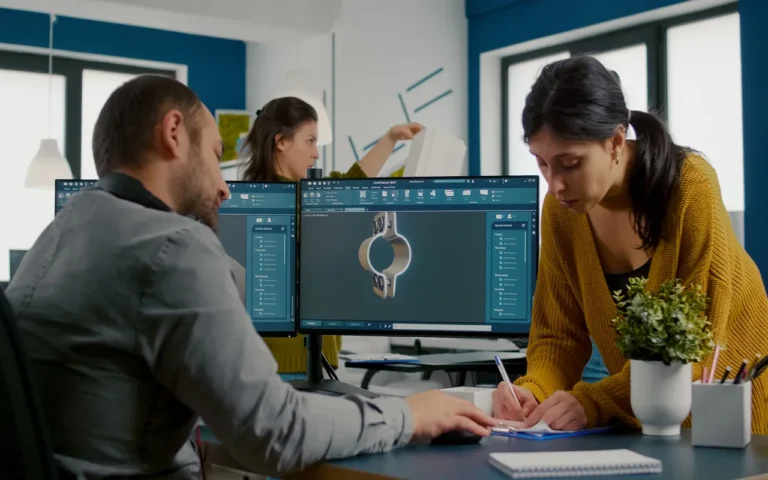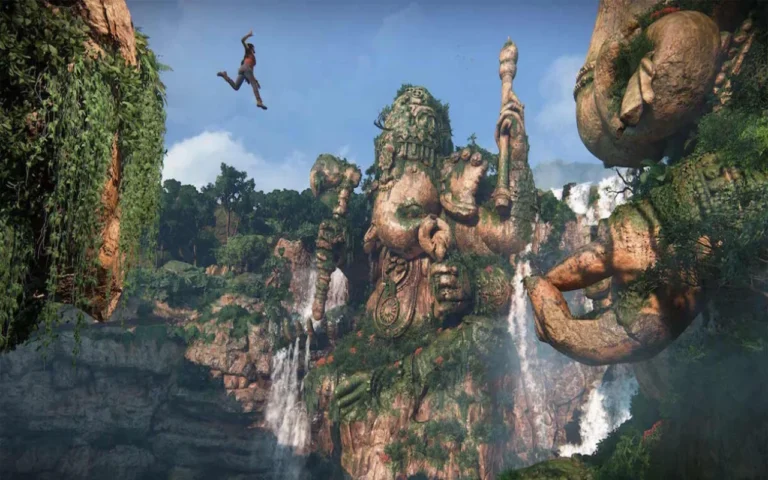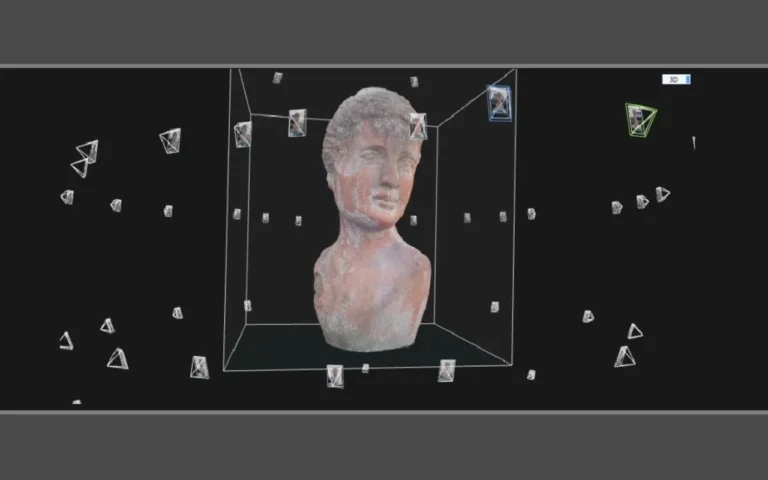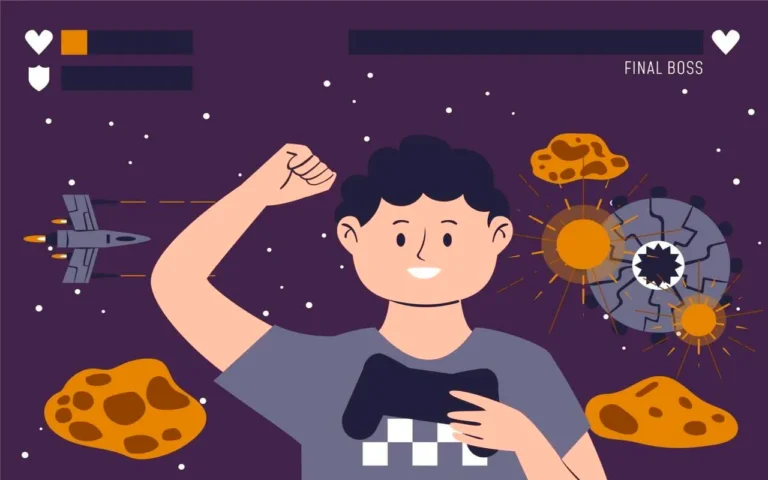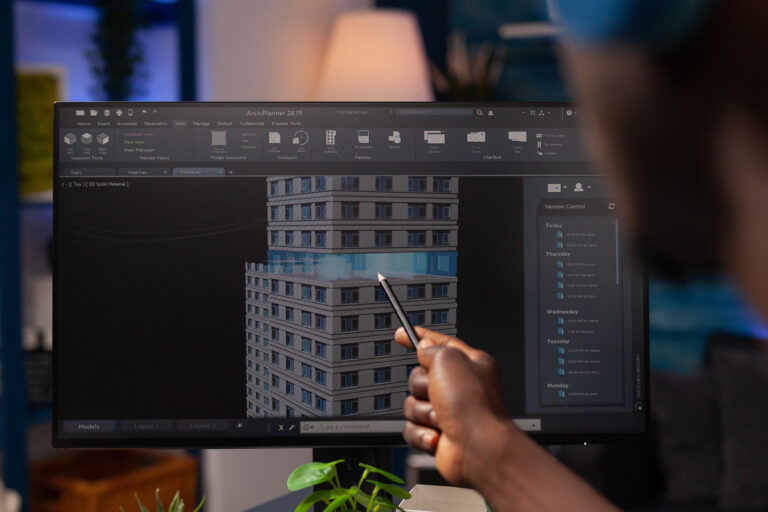Your enemy jumps across the whole screen when Scorpion’s spear hits them. People get thrown 20 feet by Ryu’s Shoryuken. Every bone in a real person’s body would be broken by Chun-Li’s legs, which appear to mix together.
None of this matches reality, but it feels perfect. That’s exaggeration at work, a core principle that top animation services use to make every move feel powerful and exciting. It turns pressing a single button into something that makes you yell at your screen.
To do this, artists make things much more unrealistic than they really are. For example, arms stretch like rubber, jumps reach heights that aren’t possible, and hits stop time totally.
You don’t just happen to know these tricks. In fact, you can read and enjoy lightning-fast battles with these well-thought-out methods.

Need Animation Services?
Visit our Animation Service page to see how we can help bring your ideas to life!
What is Exaggerated Animation?
Exaggerated animation is when animators push movements way beyond what happens in real life. They, in fact, stretch limbs longer, make jumps higher, and create impacts that shake the screen.
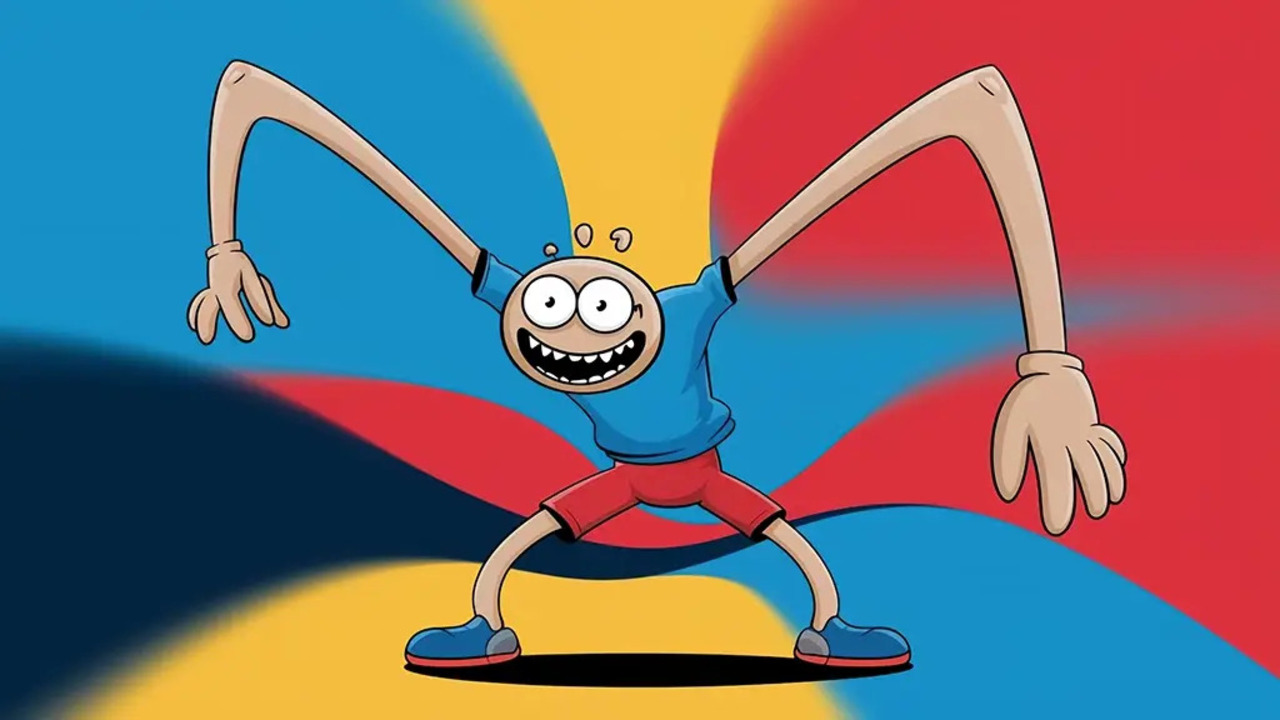
When a character throws a punch in an exaggerated style, their arm might stretch like rubber, their whole body winds up dramatically, and the hit lands with a freeze-frame moment.
Real punches don’t work like that, we all know, but exaggerated ones? They feel powerful. That’s the whole point.
Exaggerated Animation Vs. Realistic Animation
| Realistic Animation | Exaggerated Animation |
| Mimics real-world physics exactly | Bends physics for emotional impact |
| Subtle movements that mirror life | Bold, obvious movements you can’t miss |
| Often feels stiff in games | Creates satisfying, punchy gameplay |
Realistic animation tries to show how things really are, but Exaggerated animation strives to be a loudspeaker. When Ryu from Street Fighter charges his Hadouken, he doesn’t just put his hands together.
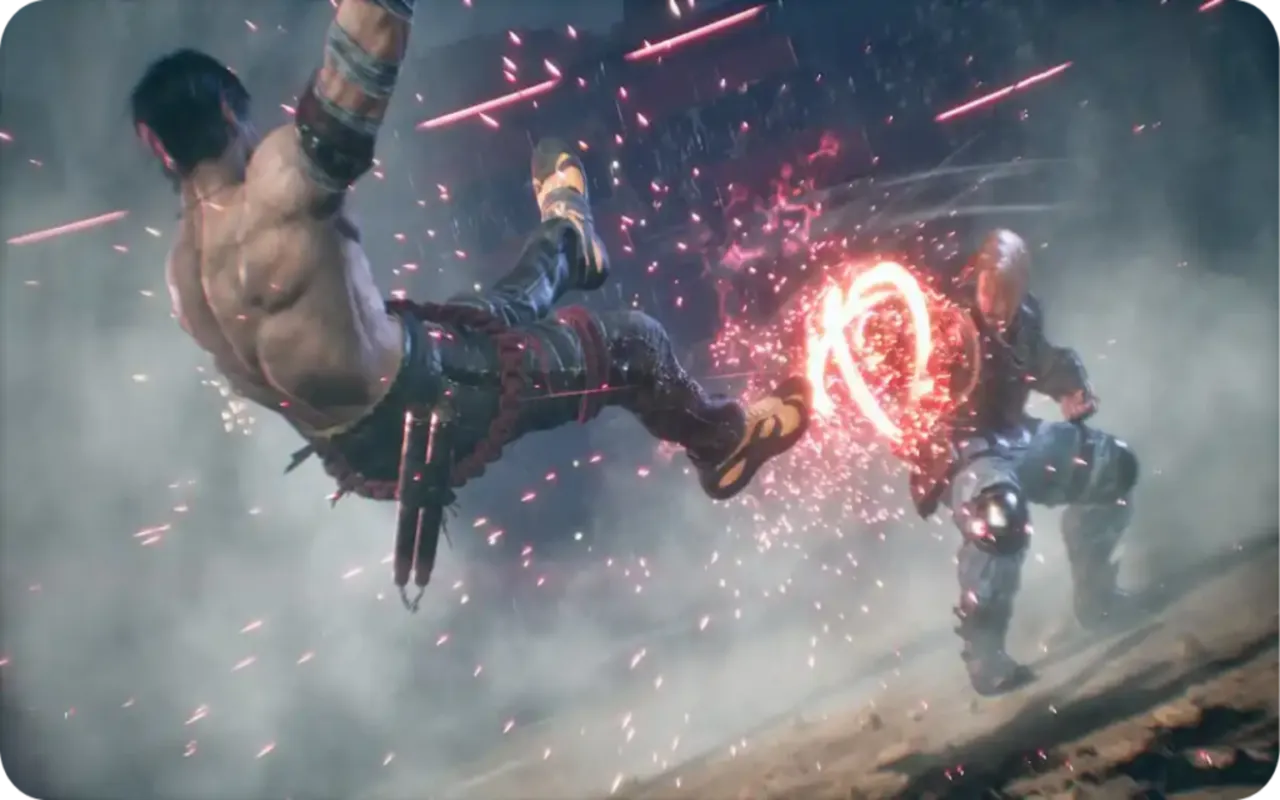
Instead, he pulls back dramatically, energy circulates around him, and the whole pose screams, “Something big is coming.” However, a guy moving his hands would be a more realistic version. Boring, yes?
In the meantime, animation that uses motion capture without exaggeration often looks weak and floaty in games.
Players are left wondering why their character’s sword swing feels like they’re waving a pool noodle. Exaggeration fixes that by adding weight, speed, and oomph to every move.
The 12 Principles of Fighting Games Animation (Disney Origins)
Frank Thomas and Ollie Johnston, two Disney animators, wrote down the rules that make animation seem real in the 1980s.
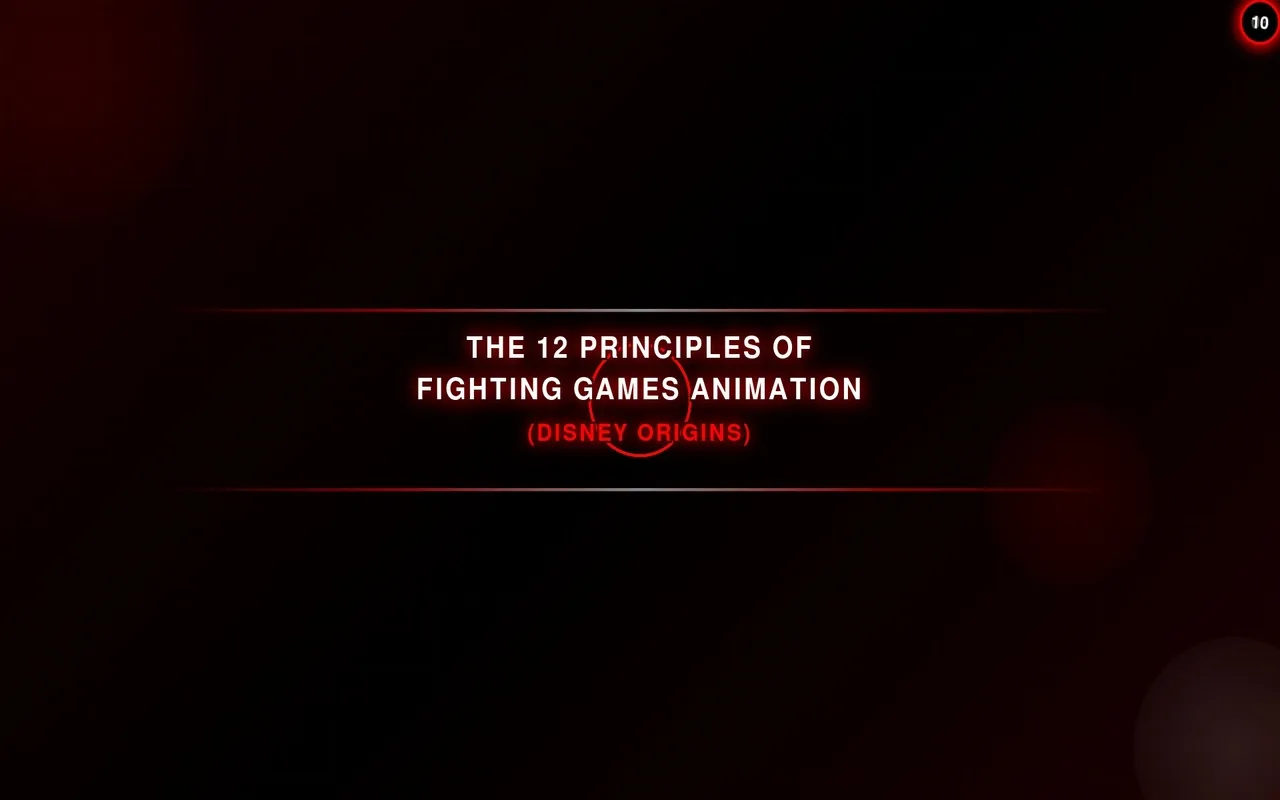
Here is a list of 12 principles of animation:
- Squash and Stretch: Things get bigger and smaller to show that they are alive and flexible. For example, when a ball hits the ground, it squashes flat, and when it bounces back up, it stretches tall.
- Anticipation: Characters get ready for big events by crouching down before jumping or pulling back their fists before punching.
- Staging: You need to set up the camera and frame the shot so that viewers can easily understand what’s going on.
- Straight Ahead Action and Pose to Pose: You can either animate frame by frame from beginning to end or plan out the most important poses first and then fill in the spaces between them.
- Follow Through and Overlapping Action: When you stop running, your hair and arms keep moving for a while, and this is because different parts of your body stop moving at different times.
- Slow In and Slow Out: Instead of moving at a constant speed, movements start slowly, speed up in the middle, and then slow down again at the end.
- Arcs: Natural movement goes in curves. When you wave, your hand makes an arc, not a straight line.
- Secondary Action: Small movements that support the main action make it more interesting, like hair flowing while running or a cape flapping during a turn.
- Timing: The number of frames an action takes affects how heavy or light it feels.
- Exaggeration: Make actions clearer and more interesting by pushing reality a little too far.
- Solid Drawing: Know how to draw flat characters with weight, volume, and three-dimensional shape.
- Appeal: Make characters look interesting and charming so that people really want to watch them.
Why Exaggeration is Principle #10 and How It Enhances the Others
Exaggeration is a number because it’s the special thing that makes the other rules work in games. Here’s why.

First of all, exaggeration turns up the volume on every other principle. Squash and stretch turns into extreme squash and stretch.
Anticipation turns into a full-body wind-up that lets you know an attack is coming from a mile away, and arcs become wider and more dramatic. Those principles do exist, but they don’t stand out.
When that pose plays in the game, it goes by so fast that you can barely see it. Animators have to push poses a lot further than what feels natural when they make them. And the truth is that players won’t see the cool stuff if they don’t.
Finally, exaggeration makes emotional truth instead of literal truth. In real life, a person who is really scared might tense up a little. But in animated movies, their eyes get big, their bodies get small, and they might even shake. That over-the-top reaction shows fear right away.
Also, during a fast-paced game, players don’t have time to look at small facial movements; they need big, clear signals. Exaggeration does just that and makes it easy to read every action and feeling at a glance.
Why Do Fighting Games Need Exaggerated Animation?
Fighting games are played at 60 frames per second. It means that each frame only shows up on screen for 16 milliseconds, which is faster than you can blink. At that speed, realistic animation turns into visual mush.
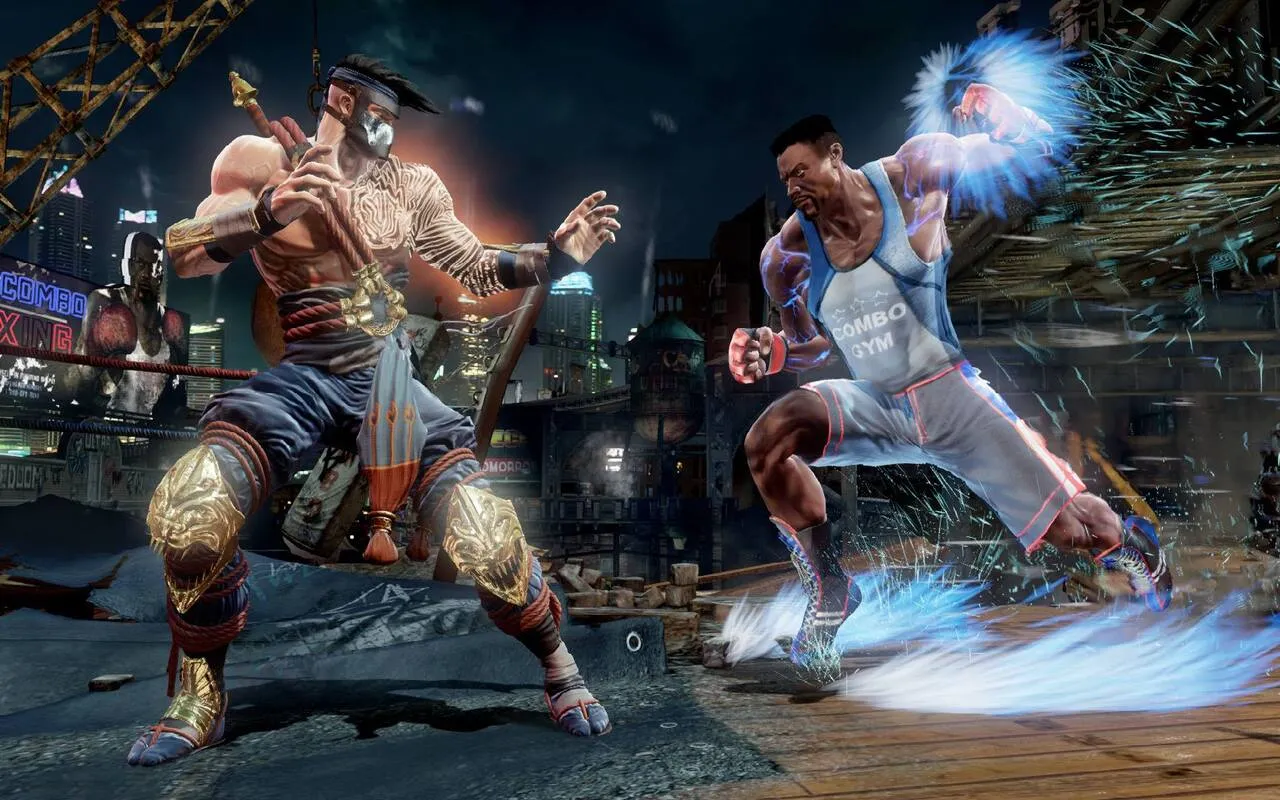
The main problem is that our eyes can’t see small details quickly. You need to exaggerate a lot to even notice that a character threw a punch in four frames. Otherwise, the moves all look the same, and players can’t tell what’s going on.
When you have to make a decision in a split second, silhouette readability becomes very important. You should be able to tell what kind of attack a character is using.
Just by looking at their shape when they are fighting. Even at 60 frames per second, exaggerated wind-ups give your brain enough time to react.
In the end, player satisfaction is always more important than realism. A fighting game that is perfectly realistic feels floaty and not fun.
When a combo lands perfectly, exaggeration gives it weight, impact, and those “hell yeah!” moments. That’s why players keep coming back.
What Are the Different Styles of Exaggeration in Fighting Games?
We have 4 main types of game and animation exaggeration, and they work in different aspects of fighting games.

1. Realistic with a Punch (Tekken, Mortal Kombat 11)
These games start out with realistic martial arts and then add some exaggeration stuff where it counts. Tekken characters use real fighting styles like karate, taekwondo, and capoeira, but the hits are harder than they would be in real life.
Plus, small changes can make a big difference in these games. A spinning kick follows the laws of physics until it hits, at which point the opponent flies back farther than they should. Your brain believes it because the setup seemed real.
When to break the rules of realism:
- Impact moments need more power.
- Combo finishers should have big launches.
- Some special moves can change the laws of physics a little bit.
- Fatal moves go completely crazy (Mortal Kombat fatalities).
- The key is to keep the base realistic so that the exaggerated moments hit harder by contrast.
2. Anime Fighter Exaggeration (Guilty Gear, BlazBlue, DBFZ)
Anime fighters take on the impossible. Characters run through the air, leave speed-line trails, and shoot energy blasts that are as big as buildings. And what about physics? Never heard of her.
Speed lines, energy auras, and effects that fill the screen make a visual mess that is still easy to read. But it works because the rules for exaggeration are always the same. When everything is too much, nothing seems out of place.
For example, Dragon Ball FighterZ uses 2D animation rules on 3D models. The characters squash and stretch like hand-drawn animation, which gives it that real anime feel. The “rule of cool” says that if something looks cool, it’s right.
3. Cartoon Physics (Skullgirls, Smash Bros.)
These games learned everything from Looney Tunes. Whenever you hit someone, cartoon dust clouds form, and characters bounce like rubber balls.
Characters feel alive and playful when they squash and stretch a lot. Mario squashes flat when landing from a jump, and Kirby stretches like taffy during his hammer swing. It’s goofy, but it creates instant personality.
Funny timing and facial expressions also make fighting funny. For a split second, a character’s face might freeze in shock before they fly off. These little things make games fun even when you don’t win or lose.
4. Stylized Abstraction (Killer Instinct, SoulCalibur)
Killer Instinct, SoulCalibur games strike the right balance between realistic and anime. Characters move with weight and purpose, but their attacks make stylized visual effects that make the drama even more intense.
When you use weapons, it feels different than when you fight with your hands. Right? In SoulCalibur, when Nightmare swings his huge sword, dark energy follows it, and the camera shakes. It’s, of course, exaggerated, but it still feels like it comes from the character’s strength.
Elemental and magical effects fill in the gaps, like:
- Fire surrounds attacks without looking like a cartoon.
- Ice effects make freezing moves look more powerful.
- Lightning sounds real, but it’s brighter than in real life.
- Wind effects show force without completely breaking the rules of physics.
How Does Exaggeration Create Visual Clarity in Combat?
Fighting games move fast. Like, really fast, 60 frames per second fast. Exaggeration is what stops those lightning-quick movements from turning into an unreadable blur.
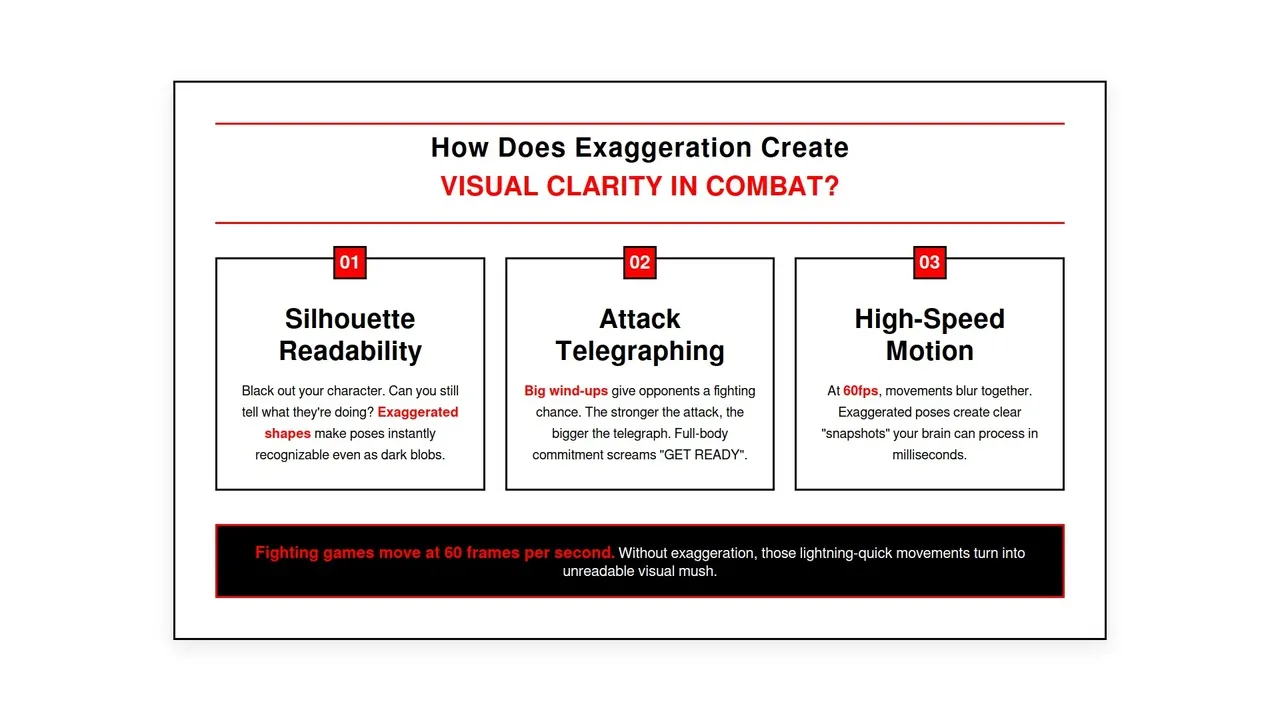
Silhouette Readability is Your First Line of Defense
The silhouette test is simple. Black out your character completely. Can you still tell what they’re doing? If yes, your animation works. If not, back to the drawing board.
Naturally, fighting game characters need to be instantly recognizable, even as dark blobs against a bright background. That’s precisely why designers go wild with exaggerated shapes.
Zangief’s massive frame screams “slow powerhouse” before he throws a single punch. Or Chun-Li’s thick thighs and compact stance shout “speed and kicks.”
You spot these differences in a split second during a match.
Body shapes do the heavy lifting here:
- Big, blocky characters = heavy hitters with slow movement
- Lean, stretched proportions = speedy combo machines
- Hunched stances = defensive or sneaky fighters
- Wide, open poses = aggressive rushdown types
When Ryu winds up for a Shoryuken, his whole silhouette changes, arms pull back, knees bend low, body coils tight. Even without seeing his face or gi details, that shape tells you “uppercut incoming.”
Meanwhile, realistic fighting games often skip this exaggeration. Characters end up looking too similar mid-fight, and players struggle to read what’s happening.
Anticipation and Telegraphing Attacks
Every attack follows a three-beat rhythm, and they are anticipation → action → reaction. Miss any beat, and the move feels off.
The anticipation phase is where exaggeration earns its paycheck. Characters don’t just move into an attack since they need to prepare for it dramatically.
For example, Dhalsim doesn’t simply extend his arm for a stretchy punch. First, he pulls back hard, his whole body compresses, then the arm shoots forward like a rubber band.
This wind-up serves two purposes. First, it sells the power. Second, it gives opponents a fighting chance.
The stronger the attack, the bigger the telegraph is:
- Light jabs = tiny wind-up, almost instant
- Medium strikes = noticeable pull-back
- Heavy attacks = full-body commitment, impossible to miss
- Super moves = theatrical poses that scream “GET READY”
Without exaggeration, telegraphing falls apart, attacks blur together, and players can’t distinguish a weak poke from a devastating command grab.
Motion Clarity During High-Speed Combat
The problem is that complex movements at 60fps turn into mush, and the solution is to break them into chunks and exaggerate each piece.
When a character performs a spinning kick, animators don’t just rotate the model smoothly. They hit specific extreme poses, like when the leg is fully extended at the peak, the body twisted to the max, and then the follow-through with everything loose.
Each pose gets exaggerated individually and creates clear “snapshots” your brain can process even at high speed.
Timing and anticipation work together here. A fast jab might only take 4 frames total, but animators still squeeze in a 1-frame anticipation and a 1-frame follow-through. That tiny exaggeration makes the difference between “did something happen?” and “oh, that was a quick punch.”
Smear frames push this to the extreme. When movement gets too fast to animate clearly, animators draw motion blur directly into the character. Arms stretch into streaks and legs become blurred arcs.
Visual effects guide your eye:
- Bright energy trails wrap around special moves (Mortal Kombat 11)
- Bold outlines highlight active characters (Guilty Gear Strive)
- Impact flashes mark successful hits
- Color-coded effects separate simultaneous actions
These aren’t just flashy decorations—they’re readability tools. When ten things happen simultaneously, color-coded effects guide your eye to what matters most.
What Animation Principles Power Exaggerated Fighting Games?
Exaggeration doesn’t work alone. It teams up with other animation principles to create moves that look good, feel powerful, and play fair.
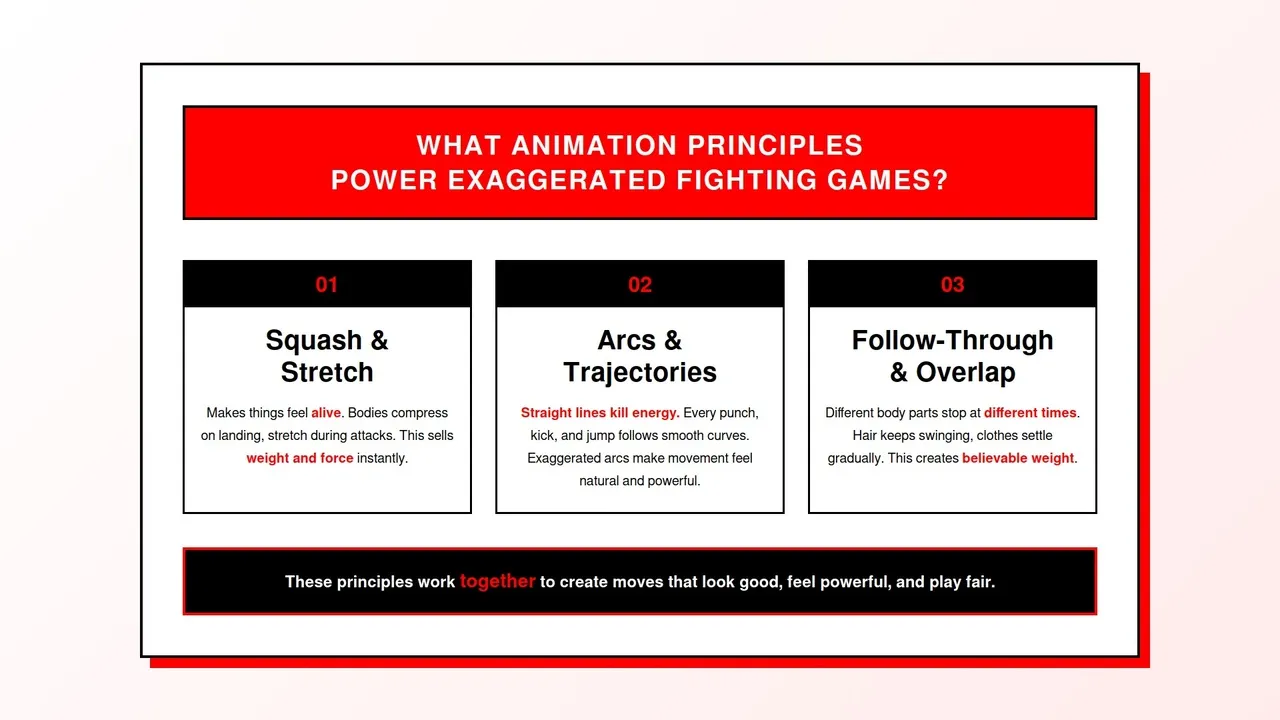
Squash and Stretch: The Basics of Impact
Squash and stretch make things feel alive by letting them get shorter and longer. Things that are stiff look dead, and those that are flexible look dynamic.
When a character jumps and lands, their body squashes down as they hit the ground. The knees bend deeply, the torso compresses, and the whole shape flattens a little. After that, they spring back up, stretching out tall before going back to their normal position.
This small change in shape sells weight and force without anyone noticing it. For example, as soon as a character charges up for a punch, they start by squashing back (which builds energy). The punch goes on with a big stretch (release), and when they hit, the opponent squashes (absorbing force). That beat makes me feel good.
The main trick is to keep the volume up even when you break the rules. A character can get 30% shorter, but they need to spread out more to make up for it. If you don’t do this, they look like they’re getting smaller instead of getting bigger.
Tekken does this perfectly: characters change shape a lot when they get hit hard, but they always feel solid. Mortal Kombat takes squash and stretch to the extreme, and Fatal blows don’t just hurt; they also look like they crush opponents like empty soda cans.
Arcs and Trajectories: Making Movement Feel Natural
Straight lines kill energy. Humans don’t move in straight lines. Our joints create curves, our momentum follows arcs, and even a simple punch traces a slight curve through space.
Exaggerating these arcs makes movement feel organic and powerful. A roundhouse kick doesn’t travel in a flat circle because it follows a rising arc, peaks at the highest point, then descends as it completes.
Hip movement drives everything else, too. The hips are the body’s center of mass, and they move in gentle arcs even during standing idle animations. So, when characters walk, run, or fight, their hips trace smooth curves that ground all other motion.
Copy hip movement directly from reference footage, and characters look floaty. But exaggerate those arcs downward, and suddenly they have weight.
Follow-Through and Overlapping Action
Everything moves at its own speed. When a character stops moving, different body parts stop at different times. That’s overlap, and it’s what separates stiff animation from fluid animation.
A character throws a heavy punch and pulls their arm back. Their torso stops first, their shoulder stops next, and their fist stops last, with a slight bounce.
Meanwhile, their hair keeps swinging for another few frames, their belt sways, and their loose clothing settles gradually. All these tiny delays create richness.
Secondary animation lives here:
- Hair flowing during rapid movement
- Capes billowing after direction changes
- Armor plates clanking and shifting
- Muscle bounce on impact
- Fat jiggle during heavy landings
Fighting games love these details. They make characters feel like they exist in physical space instead of being paper cutouts.
Overlap also creates believable weight. Heavy characters have more overlap, and their big bodies take longer to stop moving, while light characters have less and they’re more responsive.
Conclusion: The Art of Making Combat Feel Incredible
When you exaggerate, you’re not lying to players; you’re just making the truth clearer. Fights that are real happen quickly and are hard to understand. Exaggerated fighting game animation takes that crazy world and makes it clear, fun, and satisfying.
The most important thing is the delicate balance. If you don’t exaggerate enough, your game will feel stiff and boring, and if you add too much, the moves turn into unreadable cartoon chaos. So, the best fighting games are the ones that strike the right balance between style, clarity, and impact.
Street Fighter does a great job of walking this line. It’s realistic enough to feel real, but not too much so that it feels powerful. Also, Dragon Ball FighterZ goes deeper into anime territory, but it’s still easy to read. Both methods work because they stick to their chosen level of exaggeration and don’t change it.
